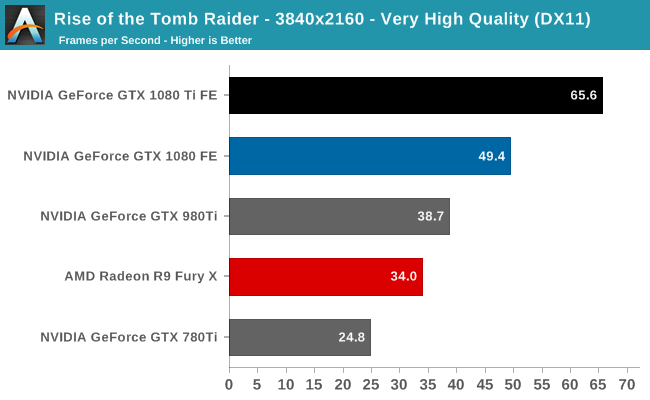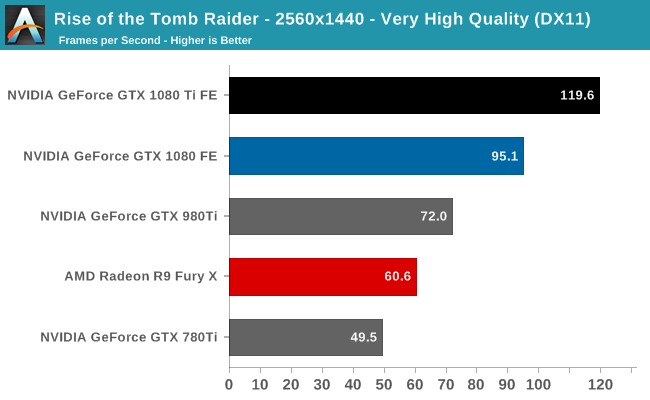The NVIDIA GeForce GTX 1080 Ti Founder's Edition Review: Bigger Pascal for Better Performance
by Ryan Smith on March 9, 2017 9:00 AM ESTRise of the Tomb Raider
Starting things off in our benchmark suite is the built-in benchmark for Rise of the Tomb Raider, the latest iteration in the long-running action-adventure gaming series. One of the unique aspects of this benchmark is that it’s actually the average of 4 sub-benchmarks that fly through different environments, which keeps the benchmark from being too weighted towards a GPU’s performance characteristics under any one scene.


As we’re looking at the highest of high-end cards here, the performance comparisons are pretty straightforward. There’s the GTX 1080 Ti versus the GTX 1080, and then for owners with older cards looking for an upgrade, there’s the GTX 1080 Ti versus the GTX 980 Ti and GTX 780 Ti. It goes without saying that the GTX 1080 Ti is the fastest card that is (or tomorrow will be) on the market, so the only outstanding question is just how much faster NVIDIA’s latest card really is.
As you’d expect, the GTX 1080 Ti’s performance lead is dependent in part on the resolution tested. The higher the resolution the more GPU-bound a game is, and the more opportunity there is for the card to stretch its 3GB advantage in VRAM. In the case of Tomb Raider, the GTX 1080 Ti ends up being 33% faster than the GTX 1080 at 4K, and 26% faster at 1440p.
Otherwise against the 28nm GTX 980 Ti and GTX 780 Ti, the performance gains become very large very quickly. The GTX 1080 Ti holds a 70% lead over the GTX 980 here at 4K, and it’s a full 2.6x faster than the GTX 780 Ti. The end result is that whereas the GTX 980 Ti was the first card to crack 30fps at 4K on Tomb Raider, the GTX 1080 Ti is the first card that can actually average 60fps or better.










161 Comments
View All Comments
webdoctors - Thursday, March 9, 2017 - link
No, its because the dollar is worthless and real inflation is off the charts. Once we make the dollar great again, we'll see prices come down.eddman - Thursday, March 9, 2017 - link
The only reason that we had $500 cards is because of the fierce competition from ATI back then.Whenever ATI's cards couldn't compete, or could but were not launched yet, nvidia jacked the prices up. I don't know why people forget the $600 8800 GTX or $650 GTX 280. Take a look at the link I posted above.
mapesdhs - Saturday, March 11, 2017 - link
What I miss is being able to buy a couple of well-priced mid-range cards that beat the high-end, with good scaling. I couldn't afford the 580 when it was new, but 2x 460 SLI was faster and served nicely for a good while. With support & optimisations moving away from SLI/CF though (lesser gains, more stuttering, costly connectors, unlock codes, etc.), a single good GPU is more attractive, but the cost way up the scale compared to 5 years ago.Have a look at the Anand review for the 280 though, it shows what I mean: 2x 8800GT SLI was faster than the 280, but $200 cheaper and with excellent scaling. I had 2x 8800GT 1GB before switching to the two 460s. Today, mid-range cards don't even support SLI (GTX 1060).
Ian.
Meteor2 - Tuesday, March 14, 2017 - link
What about two RX480s? Can they top a 1080?aryonoco - Thursday, March 9, 2017 - link
The 780 Ti was released in November 2013.The 1080 Ti is being released now, in March 2017.
So 3.5 years later, Nvidia's flagship consumer card has improved 260% while using pretty much the same amount of power and generating pretty much the same level of noise.
If this continues, I can see that in the next few years, all sort of software will find a way to utilise the GPU more, not just games and neural networks.
Nvidia has a lot to be proud of. Their execution in the past few years has been Apple-esque.
Meteor2 - Friday, March 10, 2017 - link
Reflected in their share price!virtuastro - Thursday, March 9, 2017 - link
@Ryan SmithCan you test Intel i7 7700K, Intel-E Processors, and Ryzen 7 1800x with a GTX 1080ti in benchmark? :)
Ryan Smith - Thursday, March 9, 2017 - link
Unfortunately no. We don't have a central office; I'm in the US with the GPUs, and Ian is in the UK with the CPUs. He's working on game testing for Ryzen Part 2, but we likely won't be able to include the GTX 1080 Ti.virtuastro - Thursday, March 9, 2017 - link
Aw dang. Thanks for answer anyway. :DMeteor2 - Friday, March 10, 2017 - link
FedEx?